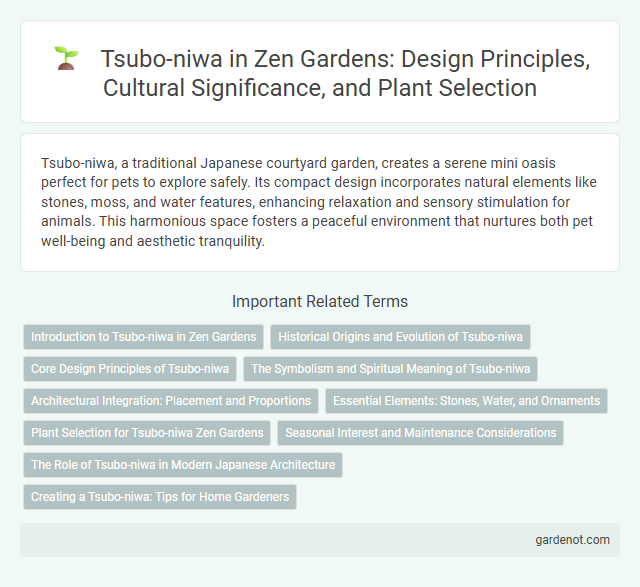Tsubo-niwa, a traditional Japanese courtyard garden, creates a serene mini oasis perfect for pets to explore safely. Its compact design incorporates natural elements like stones, moss, and water features, enhancing relaxation and sensory stimulation for animals. This harmonious space fosters a peaceful environment that nurtures both pet well-being and aesthetic tranquility.
Introduction to Tsubo-niwa in Zen Gardens
Tsubo-niwa are small, enclosed Zen garden spaces typically found in traditional Japanese homes, designed to create a tranquil atmosphere and bring nature indoors. These intimate gardens often feature carefully arranged rocks, moss, and miniature plants to evoke harmony and balance within limited urban areas. Incorporating elements like water basins and stone lanterns, Tsubo-niwa serve as meditative retreats that enhance the Zen aesthetic through simplicity and natural beauty.
Historical Origins and Evolution of Tsubo-niwa
Tsubo-niwa, traditional Japanese courtyard gardens, originated during the Heian period (794-1185) as compact gardens designed within residential and temple spaces to bring nature indoors. Over centuries, these gardens evolved by incorporating minimalist design principles, natural elements like stone lanterns, water basins, and carefully pruned plants to create tranquil sanctuaries in limited urban spaces. The evolution of Tsubo-niwa reflects the Japanese aesthetic values of wabi-sabi and shakkei, emphasizing simplicity, imperfection, and borrowed scenery to enhance the perceived depth of small garden areas.
Core Design Principles of Tsubo-niwa
Tsubo-niwa gardens emphasize compact, harmonious spaces designed to maximize tranquility through minimalism and natural balance. Core design principles include the use of asymmetry to create visual interest, incorporation of natural elements like stones, water, and plants arranged to evoke seasonal changes. Spatial efficiency and careful consideration of light and shadow enhance the serene atmosphere typical of traditional Japanese courtyard gardens.
The Symbolism and Spiritual Meaning of Tsubo-niwa
Tsubo-niwa, a traditional Japanese courtyard garden, embodies deep symbolism and spiritual meaning rooted in Zen philosophy. It represents a microcosm of nature designed to inspire tranquility, mindfulness, and meditation by harmonizing natural elements like stones, water, and plants within a confined space. This compact garden fosters a connection between the inner self and the surrounding environment, promoting balance, contemplation, and spiritual renewal.
Architectural Integration: Placement and Proportions
Tsubo-niwa exemplifies precise architectural integration through strategic placement within confined urban spaces, harmonizing indoor and outdoor environments. Its proportions are meticulously designed to complement surrounding structures, creating a seamless visual flow that enhances spatial depth and tranquility. This balance fosters a microcosm of nature, accentuating Zen garden principles of simplicity and natural harmony.
Essential Elements: Stones, Water, and Ornaments
Tsubo-niwa, a traditional Japanese courtyard garden, emphasizes essential elements such as carefully arranged stones symbolizing mountains and islands, tranquil water features that evoke calmness and reflection, and minimalistic ornaments like lanterns or bamboo fountains enhancing natural aesthetics. These components create a harmonious balance between nature and design, fostering mindfulness and serenity. The precise placement of each element embodies Zen principles, encouraging contemplation and inner peace within a confined space.
Plant Selection for Tsubo-niwa Zen Gardens
Plant selection for Tsubo-niwa Zen gardens emphasizes small-scale, harmonious greenery that enhances tranquility, such as mosses, ferns, and dwarf evergreens. Careful attention is given to seasonal changes and plant textures to maintain balance and visual interest within the confined space. Popular choices include Japanese maple, azaleas, and bamboo, which complement the minimalist stone and water features characteristic of Tsubo-niwa design.
Seasonal Interest and Maintenance Considerations
Tsubo-niwa, a compact Japanese courtyard garden, offers vibrant seasonal interest through carefully selected plants like maples, azaleas, and moss, which display striking color changes from spring to autumn. Its design emphasizes simplicity and balance, requiring regular maintenance such as pruning, moss care, and seasonal watering to preserve its aesthetic harmony. Proper attention to soil quality and shade conditions enhances plant health, ensuring the garden remains an inviting tranquil space year-round.
The Role of Tsubo-niwa in Modern Japanese Architecture
Tsubo-niwa, a traditional Japanese courtyard garden, plays a crucial role in modern Japanese architecture by enhancing natural light and ventilation within compact urban spaces. Its integration promotes mindfulness and a seamless connection between indoor and outdoor environments, aligning with minimalist design principles. This small, tranquil garden serves as a cultural and aesthetic focal point, enriching contemporary living with a sense of harmony and nature.
Creating a Tsubo-niwa: Tips for Home Gardeners
Creating a Tsubo-niwa involves designing a compact, tranquil courtyard garden that maximizes limited space while incorporating essential elements like stone arrangements, miniature trees, and water features. Home gardeners should focus on balance and simplicity, choosing plants such as moss, ferns, and dwarf bonsai to evoke a serene atmosphere. Incorporating natural materials like gravel and stepping stones enhances the Zen aesthetic, promoting harmony and mindfulness in small urban spaces.
Tsubo-niwa Infographic

 gardenot.com
gardenot.com